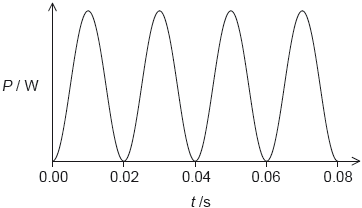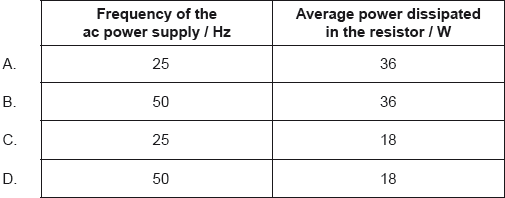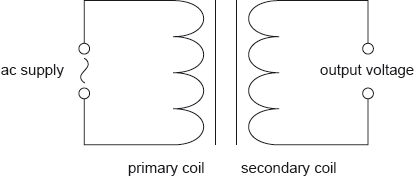| Date | November 2018 | Marks available | 4 | Reference code | 18N.2.HL.TZ0.2 |
| Level | Higher level | Paper | Paper 2 | Time zone | 0 - no time zone |
| Command term | Determine | Question number | 2 | Adapted from | N/A |
Question
A lighting system consists of two long metal rods with a potential difference maintained between them. Identical lamps can be connected between the rods as required.
The following data are available for the lamps when at their working temperature.
Lamp specifications 24 V, 5.0 W
Power supply emf 24 V
Power supply maximum current 8.0 A
Length of each rod 12.5 m
Resistivity of rod metal 7.2 × 10–7 Ω m
A step-down transformer is used to transfer energy to the two rods. The primary coil of this transformer is connected to an alternating mains supply that has an emf of root mean square (rms) magnitude 240 V. The transformer is 95 % efficient.
Each rod is to have a resistance no greater than 0.10 Ω. Calculate, in m, the minimum radius of each rod. Give your answer to an appropriate number of significant figures.
Calculate the maximum number of lamps that can be connected between the rods. Neglect the resistance of the rods.
One advantage of this system is that if one lamp fails then the other lamps in the circuit remain lit. Outline one other electrical advantage of this system compared to one in which the lamps are connected in series.
Outline how eddy currents reduce transformer efficiency.
Determine the peak current in the primary coil when operating with the maximum number of lamps.
Markscheme
ALTERNATIVE 1:
OR ✔
r = 5.352 × 10−3 ✔
5.4 × 10−3 «m» ✔
For MP2 accept any SF
For MP3 accept only 2 SF
For MP3 accept ANY answer given to 2 SF
ALTERNATIVE 2:
✔
r = 5.352 × 10−3 ✔
5.4 × 10−3 «m» ✔
For MP2 accept any SF
For MP3 accept only 2 SF
For MP3 accept ANY answer given to 2 SF
current in lamp = «= 0.21» «A»
OR
n = 24 × ✔
so «38.4 and therefore» 38 lamps ✔
Do not award ECF from MP1
when adding more lamps in parallel the brightness stays the same ✔
when adding more lamps in parallel the pd across each remains the same/at the operating value/24 V ✔
when adding more lamps in parallel the current through each remains the same ✔
lamps can be controlled independently ✔
the pd across each bulb is larger in parallel ✔
the current in each bulb is greater in parallel ✔
lamps will be brighter in parallel than in series ✔
In parallel the pd across the lamps will be the operating value/24 V ✔
Accept converse arguments for adding lamps in series:
when adding more lamps in series the brightness decreases
when adding more lamps in series the pd decreases
when adding more lamps in series the current decreases
lamps can’t be controlled independently
the pd across each bulb is smaller in series
the current in each bulb is smaller in series
in series the pd across the lamps will less than the operating value/24 V
Do not accept statements that only compare the overall resistance of the combination of bulbs.
«as flux linkage change occurs in core, induced emfs appear so» current is induced ✔
induced currents give rise to resistive forces ✔
eddy currents cause thermal energy losses «in conducting core» ✔
power dissipated by eddy currents is drawn from the primary coil/reduces power delivered to the secondary ✔
power = 190 OR 192 «W» ✔
required power «200 or 202 W» ✔
so OR 0.84 «A rms» ✔
peak current = « OR » = 1.2/1.3 «A» ✔




